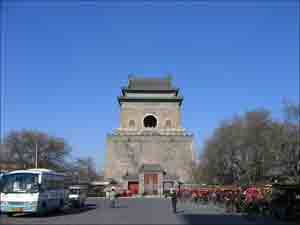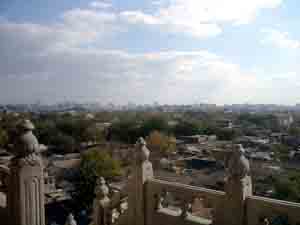| |
The Bell Tower originally housed a huge iron bell. But because its tolling was not loud enough, this was replaced by a massive cast bronze bell over 10 inches thick that is in perfect condition today. The iron bell was moved to the back of the DrumTower where it has remained for over 500 years. As recently as 1924, the bronze bell could be heard ringing out the 7:00 p.m. chime from a distance of over 20 kilometers.
According to legend, an official named Deng tried unsuccessfully for over a year to cast the bell. On the eve of the final casting, his daughter, fearing that further delays and loss of working time would bring blame on her father, decided to sacrifice her life in order to move the gods to bring about a perfect casting, and threw herself into the molten bronze. Her panic-stricken father could only recover a single embroidered slipper from the flames. The casting was a success and the emperor, moved by the young girl's spirit of sacrifice, named her the "Goddess of the Golden Furnace" and built a temple in her honor near the foundry. By the ordinary people she was remembered as the "Goddess Who Cast the Bell."
After the bell was installed, the chimes could be heard clearly and resonantly all across the city. But on stormy evenings, the bell would emit a desolate moaning sound similar to the word xie, which means "shoe" in Chinese. Recalling the old legend, mothers would comfort their children with: "Go to sleep! The Bell Tower is tolling. The Goddess Who Cast the Bell wants her embroidered slipper back."
History
The Drum Tower was built in 1272 during the reign of Kublai Khan, at which time it stood at the very heart of the Yuan capital Dadu. At that time it was known as the Tower of Orderly Administration (Qizhenglou).
In 1420, under the Ming Emperor Yongle, the building was reconstructed to the east of the original site and in 1800 under the Qing Emperor Jiaqing, large-scale renovations were carried out. In 1924, the name of the building was changed to "Mingchilou" and objects related to the Eight-Power Allied Forces¡¯ invasion of Beijing and later the May 30 Massacre of 1925 were put on display. Nowadays, the upper story of the building serves as the People¡¯s Cultural Hall of the East City District.
In the 1980s, after much repair, the Bell and Drum Towers were opened to tourists.
Function
Bells and drums were musical instruments in ancient China. Later they were used to tell time and became watches for the officials and common people as well. The Bell and Drum towers were the center of time telling during the Yuan, Ming and Qing dynasties.
Although the Bell and Drum Towers have lost their function of telling time (The function was completely lost in 1924 when the last emperor of the Qing Dynasty was forced to leave the Forbidden City), one can still hear the rings of these ancient timepieces even now.
|
|






